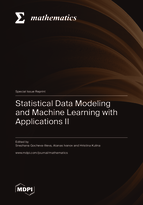Statistical Data Modeling and Machine Learning with Applications II
A special issue of Mathematics (ISSN 2227-7390). This special issue belongs to the section "Mathematics and Computer Science".
Deadline for manuscript submissions: closed (10 April 2023) | Viewed by 30968
Special Issue Editors
Interests: computational statistics; applied mathematics; data mining; computer modeling in physics and engineering
Special Issues, Collections and Topics in MDPI journals
Interests: predictive modeling; regression methods; time series analysis
Special Issue Information
Dear Colleagues,
Statistics and machine learning are two intertwined fields of mathematics and computer science. In recent years, very powerful classification and predictive methods have been developed in this area. As a rule, the new methods for statistical data modeling and machine learning provide enormous opportunities for the development of new methods and approaches, as well as for their use to effectively solve practical problems like never before.
The proposed Special Issue aims to publish review papers, research articles, and communications that present new original methods, applications, data analyses, case studies, comparative studies, and other results. Special attention will be given, but is not limited, to the theory and application of statistical data modeling and machine learning to diverse areas such as computer science, economics, industry, medicine, environmental sciences, forex and finance, education, engineering, marketing, agriculture, and more.
Prof. Dr. Snezhana Gocheva-Ilieva
Dr. Atanas Ivanov
Dr. Hristina Kulina
Guest Editors
Manuscript Submission Information
Manuscripts should be submitted online at www.mdpi.com by registering and logging in to this website. Once you are registered, click here to go to the submission form. Manuscripts can be submitted until the deadline. All submissions that pass pre-check are peer-reviewed. Accepted papers will be published continuously in the journal (as soon as accepted) and will be listed together on the special issue website. Research articles, review articles as well as short communications are invited. For planned papers, a title and short abstract (about 100 words) can be sent to the Editorial Office for announcement on this website.
Submitted manuscripts should not have been published previously, nor be under consideration for publication elsewhere (except conference proceedings papers). All manuscripts are thoroughly refereed through a single-blind peer-review process. A guide for authors and other relevant information for submission of manuscripts is available on the Instructions for Authors page. Mathematics is an international peer-reviewed open access semimonthly journal published by MDPI.
Please visit the Instructions for Authors page before submitting a manuscript. The Article Processing Charge (APC) for publication in this open access journal is 2600 CHF (Swiss Francs). Submitted papers should be well formatted and use good English. Authors may use MDPI's English editing service prior to publication or during author revisions.
Keywords
- Computational statistics
- Dimensionality reduction and variable selection
- Nonparametric statistical modeling
- Supervised learning (classification, regression)
- Clustering methods
- Financial statistics and econometrics
- Statistical algorithms
- Time series analysis and forecasting
- Machine learning algorithms
- Decision trees
- Ensemble methods
- Neural networks
- Deep learning
- Hybrid models
- Data analysis








